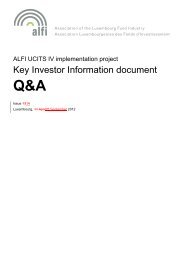Real Estate Investment Funds: Financial reporting - Alfi
Real Estate Investment Funds: Financial reporting - Alfi
Real Estate Investment Funds: Financial reporting - Alfi
Create successful ePaper yourself
Turn your PDF publications into a flip-book with our unique Google optimized e-Paper software.
accounting<br />
10. How do funds treat<br />
currency or interest<br />
rate hedges?<br />
a. Under LuxGAAP, and INREV guidelines,<br />
interest rate hedges are recorded at fair value.<br />
b. Under IFRS, a hedging relationship qualifies<br />
for hedge accounting if all of the conditions<br />
specified in IAS 39 are met. Interest rate<br />
hedges are typically classified as cash flow<br />
hedges. If the interest rate hedge qualifies for<br />
hedge accounting, then the portion of the<br />
gain or loss on the interest rate swap that is<br />
determined to be an effective hedge (under<br />
IAS 39), is recognised in other comprehensive<br />
income, and the ineffective portion of the<br />
gain or loss is recognised in the statement of<br />
comprehensive income.<br />
For interest rate hedges not meeting the<br />
conditions for hedge accounting, the gain<br />
or loss is recognised in the statement of<br />
comprehensive income.<br />
c. The Fund Documentation may specify how<br />
interest rate hedges are to be accounted for<br />
in the Fund NAV calculation, which can<br />
differ from the financial statement treatment<br />
by taking into account their intended<br />
purpose. For instance, for closed ended funds<br />
where the effective interest rate hedges are<br />
almost certainly held till maturity, the value<br />
of these hedges at the end of the life time of<br />
the fund are nil and therefore an adjustment<br />
to derecognise the hedges may be specified to<br />
avoid their impact on the Fund NAV during<br />
the life of the fund. This is in line with the<br />
INREV guidance for closed ended funds<br />
when determining the "NAV for property<br />
performance measures". The assessment of<br />
the intended purpose of the interest rate<br />
hedges should be re-considered at each Fund<br />
NAV date to substantiate the derecognition<br />
adjustment to the Fund NAV. In the case of<br />
the "fixed to variable" interest rate swap<br />
agreements, the approach should be<br />
consistent with the measurement of the fixed<br />
rate debt (refer to Chapter III.4).<br />
d. Under both IFRS and LuxGAAP, if currency<br />
swaps meet the applicable criteria for hedge<br />
accounting, and are being used to hedge<br />
specific balance sheet positions, they are<br />
treated as fair value hedges. Thus, by<br />
recording them at fair value through the<br />
profit and loss account, they offset<br />
movements in the carrying value of the<br />
corresponding asset or liability as a result of<br />
currency translation.<br />
11. How do Luxembourg<br />
REIFs treat deferred<br />
tax liabilities?<br />
a. Under Luxembourg GAAP the Fund has the<br />
general requirement to account for tax<br />
liabilities including deferred taxation arising<br />
on revaluations of investment property on a<br />
fair value basis if they are likely to<br />
crystallise in the foreseeable future or<br />
resulting from a planned transaction, under<br />
the general provisions requiring the<br />
application of fair value principles in<br />
determining the LuxGAAP NAV of<br />
Luxembourg funds.<br />
b. As well as providing for specific tax<br />
liabilities, there will be some deferred<br />
taxation impact (e.g. latent capital gains tax<br />
liabilities included in negotiated disposal<br />
prices of shares of SPVs holding investment<br />
properties or upon disposal of property<br />
assets directly), and this should be taken<br />
into their Fund NAV calculation if it is<br />
likely to crystallise in the foreseeable future.<br />
c. In such cases, the notes to the financial<br />
statements should disclose more details with<br />
respect to the deferred tax accounting, e.g.<br />
to disclose the deferred tax amounts that<br />
were not recorded. A re-assessment of the<br />
intended method of disposal or impact of<br />
structuring should be made at each NAV<br />
date. This re-assessment should also take<br />
into account current market circumstances<br />
affecting disposal strategies.<br />
d. Under IFRS, in general, deferred taxes<br />
need to be provided for in full irrespective<br />
of the method of disposal. The calculation<br />
of the amount of deferred tax is impacted<br />
by judgments on the effective tax rates to<br />
apply, and whether the asset was acquired<br />
through a business combination or an<br />
asset purchase.<br />
e. For many Luxembourg REIFs which prepare<br />
IFRS financial statements, adjustments are made<br />
to the NAV to adjust the amount of the deferred<br />
tax included. This is done to reflect the likely<br />
outcome of tax structuring and real estate<br />
market conditions, thereby producing a better<br />
estimate of fair value. Such adjustments fall<br />
within the scope of Chapter IV.1 in this paper.<br />
18

















